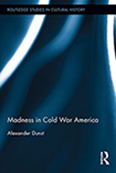Historical and cultural perspectives of madness in the Cold War (1945-1989)
DOI:
https://doi.org/10.11606/issn.2316-9141.rh.2021.167449Keywords:
Cultural History, Cold War, United States, Politics and culture, CountercultureAbstract
The present review on the book Madness in Cold War America by Alexander Dunst seeks to present the trajectory of madness between a pathology and the rhetoric of culture and the American state. From five densely constructed chapters, the author presents the importance of locating madness as a product of the Cold War. From literary and cinematographic sources the author makes an intense analysis on how psychoanalysis and psychiatry became popular in the daily lives of Americans. In addition, the rhetoric of the American government also used the theoretical vocabulary of psychoanalysis to frame individuals who were compatible with liberal ideology, thus, the polarization between normal and mad has extended both to a condemnation of the Soviet Union and to irrational / pathological as also to frame acceptable behaviors in American society.
Downloads
References
BOURKE, Joanna. An intimate history of killing: Face-to-face killing in twentieth-century warfare. Basic Books, 1999.
CUSHMAN, Philip. Constructing the Self, Constructing America: A Cultural History of Psychoterapy. Boston: De Capo Press, 1996.
MAY, Elaine. Homeward Bound: American Families in the Cold War Era. Nova Iorque: Basic Books, 2017.
PEEL, Robin. Writing Back: Sylvia Plath and Cold War Politics. Madison: Farleigh Dickinson University Press, 2002.
WALLERSTEIN, Immanuel. O universalismo europeu: a retorica do poder. São Paulo: Boitempo, 2007.

Downloads
Published
Issue
Section
License

This work is licensed under a Creative Commons Attribution-NonCommercial 4.0 International License.
Autores que publicam nesta revista concordam com os seguintes termos:
- Autores mantém os direitos autorais e concedem à revista o direito de primeira publicação, com o trabalho simultaneamente licenciado sob a https://creativecommons.org/licenses/by/4.0/ (CC BY). Esta licença permite que outros distribuam, remixem, adaptem e criem a partir do seu trabalho, mesmo para fins comerciais, desde que lhe atribuam o devido crédito pela criação original. É a licença mais flexível de todas as licenças disponíveis. É recomendada para maximizar a disseminação e uso dos materiais licenciados.
- Autores têm autorização para assumir contratos adicionais separadamente, para distribuição não-exclusiva da versão do trabalho publicada nesta revista (ex.: publicar em repositório institucional ou como capítulo de livro), com reconhecimento de autoria e publicação inicial nesta revista.
- Autores têm permissão e são estimulados a publicar e distribuir seu trabalho online (ex.: em repositórios institucionais ou na sua página pessoal) a qualquer ponto antes ou durante o processo editorial, já que isso pode gerar alterações produtivas, bem como aumentar o impacto e a citação do trabalho publicado (veja O Efeito do Acesso Livre).
















